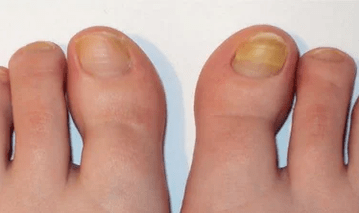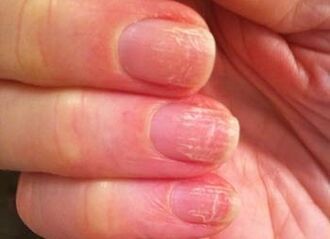
Mycosis, called fungal diseases in everyday life, have an infectious nature and are easily transmitted in contact with an infected person, animal or object.
Once on the skin or nail plate, the fungus immediately begins to eat scarves in which it appeared, gradually establishing more and more area.With its enzymes, the fungus breaks down the keratin, which is part of the skin tissues, hair and nails, that is, destroying them.
Nail mycosis in the initial stage differs only in a less notable manifestation.But the disease is homogeneous throughout the period of the course of the course and the base of the treatment used.
How the nail fungus begins: symptoms and photos
Initial nail mycosis cannot always be seen by accident, since its manifestations can be insignificant.
The possible symptoms of this disease are the following:
- Change the color of infected areas, often yellowing;
- the disappearance of the nail brightness;
- the appearance of points in relief, points or nail strips;
- thickening, wave, fragility or peeled of infected areas;
- Partial destruction of the nail along the edges and the skin on the nail;
- itching or pain in infection;
- An unpleasant smell of the nails.
The phenomena listed can be symptoms of mycosis and a consequence of other factors, for example, the following:
- lack of vitamins and minerals;
- accumulation of dead skin or dirt;
- wounds;
- Taking some drugs;
- Non -infectious diseases: diabetes, psoriasis, eczema.
Therefore, for the precise diagnosis of mycosis, even in the presence of symptoms, a laboratory analysis of the affected fragment of the nail plate is necessary.
Symptoms of the initial nail fungus in the hands: photo

Nail mycosis in the hands is somewhat less common than in the legs.
Its manifestations are the same:
- stench;
- itching and pain;
- Atrophy of the nail plate and the skin on it;
- Change in the shape and color of the nail plate;
- Loss with brightness and a change in its color.
The same symptoms may indicate the following factors:
- Incorrect nutrition
- Long contact with chemical detergents or reagents
- Taking certain drugs
- Some diseases of a non -infectious nature.
Methods to treat the initial fungus of the nail
It is necessary to treat fungal infections, since this not only spoils the appearance of the hands or feet, but also leads to deteriorated immunity.As a result, people with nail fungi are more prone to colds, influenza and other infectious diseases.
Any way of treating nail mycosis must necessarily include measures to prevent infection.With the affected tissues, the fungus falls on clothes, shoes and other items that the patient plays with the fingers or legs.
Therefore, the following rules must be followed:
- Infected shoes that were used before the start of the treatment, deal with special means or through them.
- Before complete recovery, use cotton socks.
- Do not wear any shoes, except those that are easy to wash (with a smooth internal surface).
- Change the socks and gloves to clean every day, and used to wash at high temperature and iron.
- It is advisable to treat shoes with ultraviolet antifungal coatings throughout the treatment.
According to representatives of professional medicine, nail mycose even in the initial stage requires systemic treatment in the first place and the external in the second.The drug selection is carried out depending on the type of existing fungus.Laboratory tests can determine it.
- Systemic anti -inflam, or antimicotic agents.They accumulate in the nails and the skin of the skin of the skin.Penetrating the fungus into the cells, the active components of the medications destroy their membrane or stop the synthesis of the substances with which it feeds.As a result, the fungus dies.The treatment must last at least 3 months according to the following scheme: one week of admission, a three -week break;So repeat 2 times.After that, for another six months, the medicine will be present in the tissues affected by the fungus.Therefore, a healthy nail will have time to grow, and the fungus will not apply to it.The remaining treatment methods are used in addition to systemic therapy.The use of only local exposure methods can cure infection for some time, but in this case there is a risk of relapse.
- Antifungal medications for local use.These drugs soften the consistency of the nails affected by plasticine.This effect allows you to easily eliminate nails affected by the fungus, accelerate the growth of the new nail and increase the effectiveness of systemic medications.Antimicotic agents occur in the form of varnishes or ointments.The affected nails are covered with varnish, and an ordinary cosmetic varnish is applied at the top.
- Medical PedicuraThis method is the elimination of tissue tissue affected by a fungus and a soft grinding and feet with a special tool with many nozzles.The procedure lasts from 15 minutes to 2 hours and is carried out from 1 to 2 times a month.The duration of treatment is 3 months to a year.The medical pedicure is performed in specialized offices.Not only does the infection treat, but also improve the appearance of the nails.After the first procedure, they look much better.And the recovery signs become notable in the first 3 weeks of treatment.
- Ozonotherapy.The introduction of ozone in soft tissues near the nails reduces inflammation and increases local immunity.The treatment course is at least 10 procedures that occupy up to 20 minutes each.They are carried out from 1 to 2 times a week.
- Traditional medicineIt offers the following method to treat nail fungus.The following sequence of shares should be performed daily for at least 3 months or even a complete recovery.At night before bedtime, cook to cook the legs or arms (depending on the location of the infection) in a solution of drinking soft drinks with a temperature of 50 degrees.In each nail of the affected limb, apply cotton cotton, either saturated with hydrogen peroxide or apple vinegar.Close the foot (brush) with a plastic wool with cellophane or paste with a patch and go to bed.Throughout the treatment period, cut the nails as necessary, as usual.
Prevention
The sources of infection with fungi are:
- Public places where they go without shoes: bathrooms, saunas, showers, sports rooms, beaches;
- Public articles: shoes (more frequent), gloves (for example, boxing);
- carpets, more frequently in the bathrooms;
- Animals, including domestic and wool that has fallen from them;
- floor.
To minimize the probability of infection, it is necessary to observe the hygiene rules:
- If possible, avoid contacts with sources of infection, especially with common shoes and clothes
- Do not wear tight shoes
- Apply ultraviolet antifungal coatings for cohabitation shoes with a person suffering from mycosis.
You should know that fungi can come alive after several months of stay in a dry state.
The risk factors that are not surprised are the inheritance and slow growth of the nails.The fungus is easier to extend through a slow growth.Its growth rate decreases with age.
Immunity in this disease does not play an important role, since in the nail area it is much less than in most body systems.
Professional medicine treats mycosis successfully, both in the initial and later stage.However, it is not possible to get rid of this disease without addressing a specialist.





























